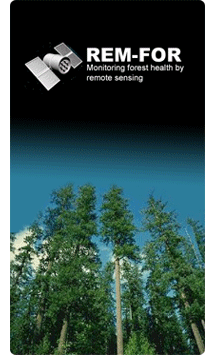Some Results
Some Results
LAI estimation from hyperspectral data
The proposed method is based on classifying each high resolution pixel, computing the proportion of classified tree and ground pixels in a selected lower resolution, and relating the ground proportion estimate to LAI using an expression similar to Beer-Lambert's law. A Gaussian maximum likelihood classifier was applied to classify the data, but other classifiers may be applied as well (se figure below). The proposed method outperforms methods based on ratio vegetation indices and normalized difference vegetation indices, and we are able to estimate the LAI of a test scene with a coefficient of determination of 0.73. However, the results also show that the LAI estimation performance depends on the accuracy of the land cover classification.

Left: Lidar based LAI image. Right: LAI image derived from hyperspectral data (right). Both images have 20x20m resolution.
LAI estimation from synthetic aperture radar
In this work we estimated the Leaf Area Index (LAI) using ENVISAT ASAR alternating polarization and Radarsat-2 quad polarization SAR data. The radar backscatter was analysed as a function of LAI to investigate the expected performance, and two different methods are applied for estimating the LAI from radar backscatter. The first was block averaging SAR data, whereas the second method performed averaging of segments with homogeneous LAI values. From the analysis we observed that the HH- and XX-channels saturated for LAI values larger than 1-1.5, but the VV-channel did not. The estimation results clearly shows that Radarsat-2 performs much better LAI estimation than ENVISAT ASAR, and the method based on segment averaging resulted in less noise scatter plots and higher coefficient of determination than the method based on block averaging. Using all polarizations and a quadratic model of the Radarsat-2 data, we obtained as coefficient of determination as high as R=0.72 for segments larger than 144 pixels (see figure below), but the VV-channel performed nearly as good (R=0.67). The study shows that satellite based SAR, and in particular Radarsat-2, has the potential for estimating LAI of large areas for small and moderate LAI values.

LAI versus predicted LAI using all polarizations ofthe Radarsat-2 image (Sept. 3, 2008) and a quadratic model. The coefficients of determination is R=0.72.

